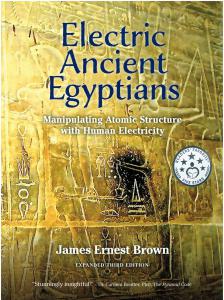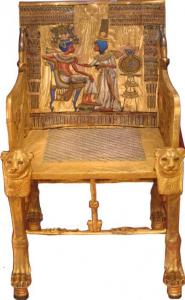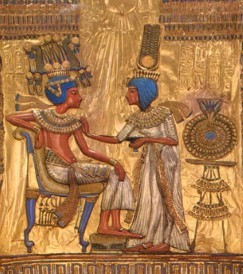Tutankhamen's Chair: Electricity in Ancient Egypt
Have Ancient Egyptian Objects Been Misinterpreted?
Tutankhamun's throne/chair is wood and completely covered in gold foil (except for two-three inches at the bottom of the wooden legs), in some places silver, and is inlaid with semi-precious stones and glass paste. The exquisite and detailed images on the back of the chair show the seated Tutankhamun, with his wife and queen, Ankhesenamun, who is holding a dark container and touching the large metallic collar around his neck and shoulders. The image of the sun god Aten shines down on the couple, perhaps representing the energy of the solar rays. The chair is a beautiful work of art, but the cold metal must have been very uncomfortable to sit in. Tut’s whole body would have touched the metal. Perhaps its purpose was special ceremonies related to the transmission of electricity and the chair was not meant for comfort.
It is interesting to note that the image on the back of the chair shows king Tut seated in a similar chair, but not identical, to the gold chair itself—a chair within a chair. The Egyptians were a profoundly symbolic culture, so it seems that the back of the chair must tell an important story or depict an important ritual. Perhaps this image is a clue to the chair’s true purpose. Brown believes the image on the back of the chair illustrates the chair’s actual purpose, using natural forms of electricity as part of a larger plan to enhance the lives of ancient Egyptians.
Gold is one of the best conductors of electricity, but since Tutankhamen’s feet are off the ground, elevated on what seems to be a wooden stool, so he would not be grounded. The chair legs have wooden bases, and the bottoms of the legs are not covered with gold, so the chair itself is also not grounded. Tutankhamen could become an electrical capacitor capable of generating and storing electricity in his body and he would be able to discharge the electricity at will for beneficial purposes. Seen this way, Tutankhamen’s gold chair takes on a completely new meaning.
The elaborate crowns the couple wears seem too large and unwieldy to merely represent their royal status, so perhaps they also have another purpose. It is also curious that the scarf Tut wears is not lying flat against his back but appears to be elevated as if blown by a breeze or wind current.
His wife Ankhesenamun appears to be actively administering something with her right hand while she holds a container in her left hand. Tutankhamen’s wife could be stroking him to build up an electrical charge. Perhaps she is also building up energy in the large metal collar he wears. She appears to be holding a container of sorts in her left hand as she strokes him. Egyptology’s conventional interpretation is that Tutankhamen’s wife is anointing him with perfume. She is standing on the ground, giving her full access to Earth’s electrical properties.
Tutankhamen appears to have two left hands and is sitting in a “receptive” or “passive,” position. It is curious that in Egyptian art figures sometimes have two right hands or two left hands. At other times, the figures clearly have a right and left hand. These depictions were not “mistakes” but instead had symbolic meaning. We tend to think of the right hand as active and the left as receptive. It is also interesting that Tutankhamen and his wife both wear only one sandal on the opposite feet—his sandal is on his left foot and hers is on her right. This could suggest an exchange of energy of a different but balanced polarity.
As part of his ongoing research, Brown purchased a replica of Tutankhamen's chair that is actually covered in real gold leaf. If someone sits in the chair, with feet off the ground on a wooden block, and a static electrical charge is introduced, the person feels the electricity everywhere the body touches the gold foil.
Brown has used the chair in other experiments with electrical charges. He has transferred the electrical charge to a metal disk suspended on a string by touching it while someone was sitting in the chair. Static electricity could be seen jumping from the seated person to the metal disk. As long as the person holding the disk does not touch anything, the electrical charge remains in the disk. When the disk is grounded to another object, electrical sparks are visible and jump from the disk to the grounded object. A recent study at Boston University, reported by Live Science, found that mild electrical stimulation improves brain function in the elderly.
James Brown believes Tutankhamen’s chair was an electrical device used by the ancient Egyptians as part of their wider culture that he explores in his multiple gold medal award-winning book Electric Ancient Egyptians: Manipulating Atomic Energy with Human Electricity.
James E Brown
Ancient Energy Research Center
+1 970-731-3071
email us here
Legal Disclaimer:
EIN Presswire provides this news content "as is" without warranty of any kind. We do not accept any responsibility or liability for the accuracy, content, images, videos, licenses, completeness, legality, or reliability of the information contained in this article. If you have any complaints or copyright issues related to this article, kindly contact the author above.



